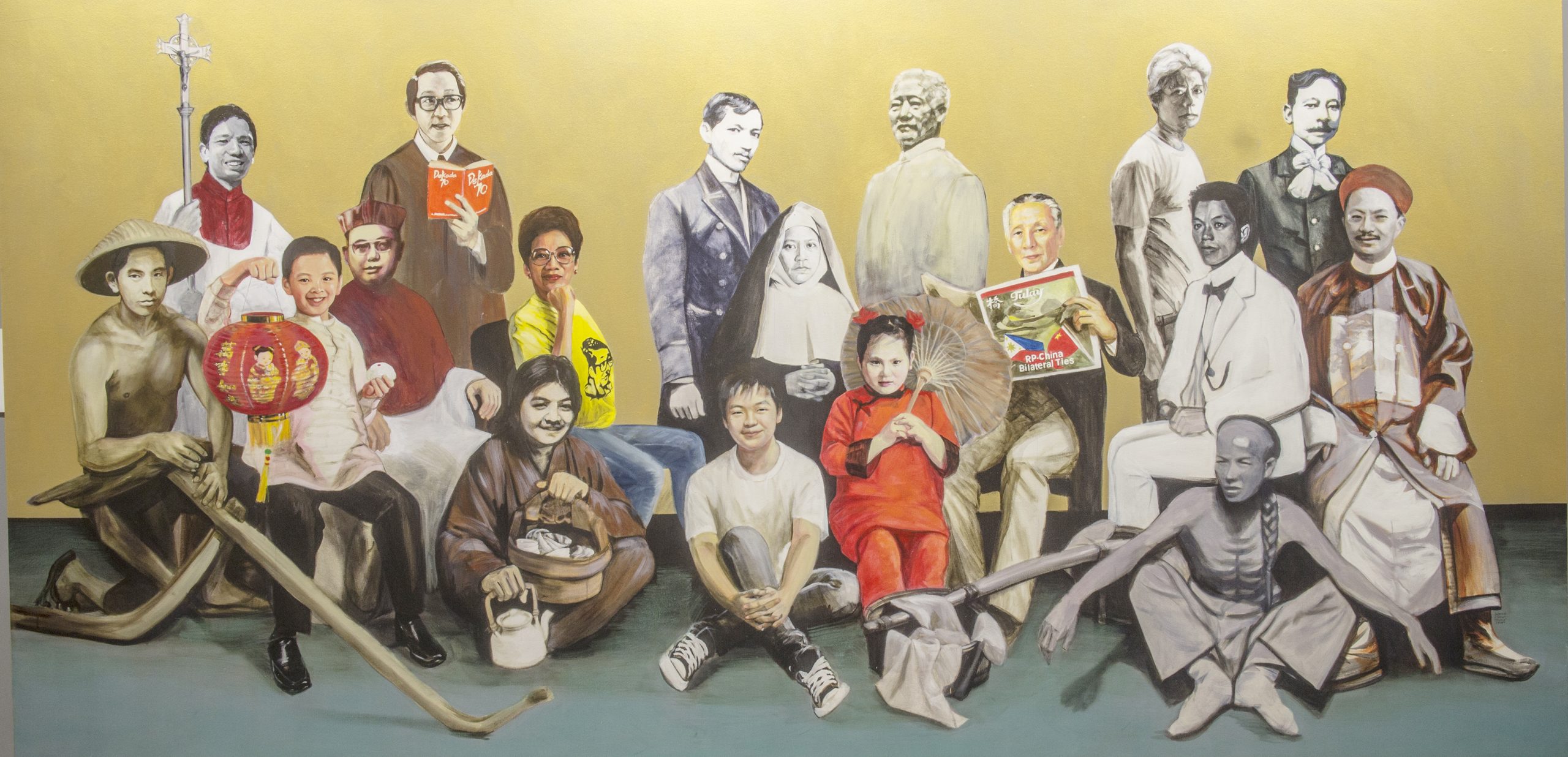There are always hard-to-miss moments whenever Janice Liuson-Young (柳真女) looks at people’s faces. Even as a child, she would often sketch people in her free time using pencils.
She has come a long way since those childhood days. Today, she is Associate Dean of Fine Arts at FEATI University in Manila.
Because she was constantly sketching, she realized she could actually draw, and eventually, paint.
“I like to paint the human form and face, and other elements of nature,” she says.
Young was so committed to art that she studied Fine Arts at the University of the Philippines in Diliman, Quezon City, major in Visual Communications. She graduated cum laude and valedictorian of batch 1986.
Young shares that her human condition themes emanate from her deep reading and appreciation of the Scripture.
“I take inspiration from the Holy Word of God,” she says. Her faith plays an important place in her life and work.
“I made many mistakes in life and career, but was able to cope with the help of my faith in God. I have been going to Sunday School every Sunday at Christian Gospel Center since I was a child, something (for which) I am thankful to my parents.”
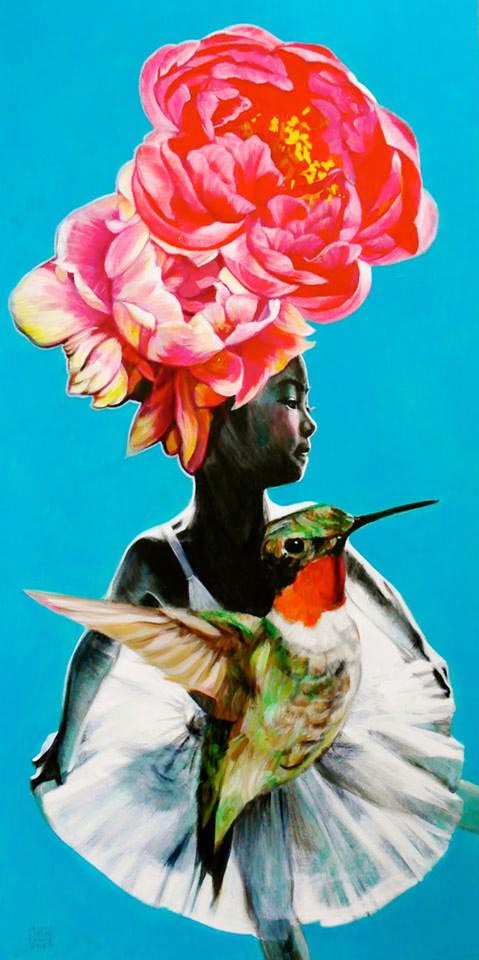
In November 2014, her exhibit was titled “Not Even Solomon.” It is a Biblical reference that even the Israelite king in his royal finery could not match the beauty God has endowed to nature: “See how the flowers of the field grow… not even Solomon in all his splendor was dressed like one of these.” (Book of Matthew, New International Version)
“I believe that life is both real as well as a metaphor for a deeper reality, and a foreshadowing of realities to come,” she adds. “To my mind, the artist’s job is to be sensitive to those instances when the metaphor is revealed, and to capture and interpret it for others.”
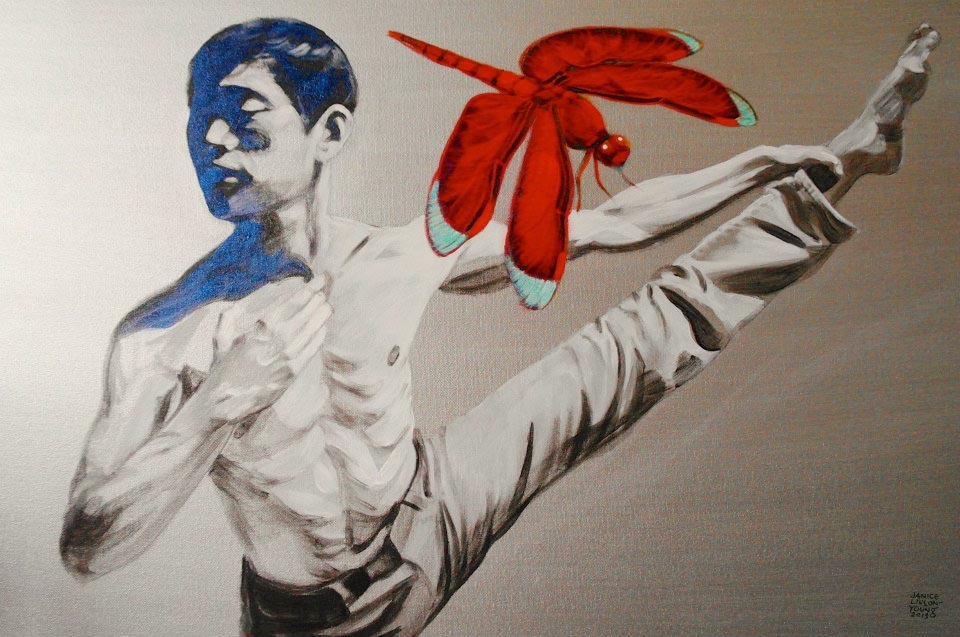
Like other artists, she has her ups and downs.
“An artist will usually be frustrated with some aspects of his or her work. After all, we are generally perfectionists by nature. However, there are times when the finished or near-finished work exposes the bankruptcy of the original concept. Then the artist may have to scrap the work altogether, or infuse the work with a new vision.”
Young has been FEATI’s associate dean since 2005.
To balance her work and art, it takes organization. “Yes, it does takes some scheduling and prioritization, but thankfully my work at FEATI does leave me sufficient time with my artwork.”
Work for Young is a way to give back what she receives from God and others. “It is a way to love back, as I have also been loved and accepted; a way to become who I was created to be.
And when it is done with excellence and joy, then work is also art.”
Descended from generations of Tsinoy businessmen, Janice is influenced by both Chinese culture and the Philippines, which has given her clan a good home.
“My grandfather, Liu Pek Lin, was the first to (come over) from China.
“The Chinese culture still exerts a strong influence in my life and in my family members, although that culture is essentially a Filipino-Chinese variant, and one which has been (largely influenced by Christianity). Thus, while heirs to much of Chinese tradition and values, we are very much Filipino, and very much Christian, and this mix makes us rather distinct.”
Young speaks Hokkien and a little Mandarin.
Indeed, Young has spent her life mostly in Tsinoy surroundings.
She was born in Quezon City to parents David Liuson and Virginia Go Liuson, both born in 1937.
“My father used to be a businessman. He and his brothers moved to the U.S. in 1988. Though he is retired, he still works part-time in San Francisco. My mom remains a housewife and loving mother to us. She cooks and sews very well and works as a florist there.”
Growing up, she attended Grace Christian High School, a Tsinoy-run Christian school in Quezon City, placing third and fourth in high school. She worships in a Tsinoy church. She is married to Tsinoy lawyer Frederick Young, who placed seventh in the 1990 Bar exam.
She has four sons: Zachary, who finished Fine Arts at U.P. (majored in Industrial Design); Isaiah, a marketing graduate from De La Salle University; Ezra, an incoming third year of Legal Management at the Ateneo University; and Sean, incoming grade eight at the Mont Michel School, Quezon City.
“I served in the church as an officer in the fellowship meetings and worship services since my teen years up to the present. I am an evangelical Christian and attend the Christian Bible Church of the Philippines headed by Reverend Jeremiah Cheung.”
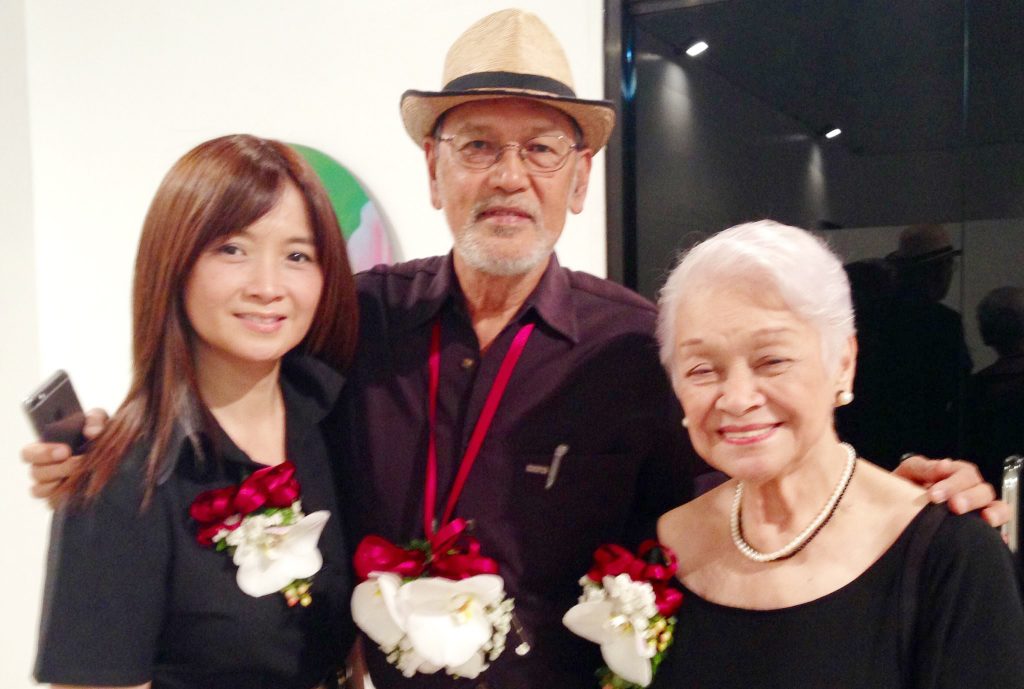
Indeed, going to university was a step out of the Tsinoy community into mainstream Filipino society. Young’s works are sources of pride since everything, she says, are the fruits of her heart and soul.
“I’m proud of all my works since I gave my whole self in each and every one of them. That includes even commissioned works such as my portrait of Atty. Marvic Leonen, past dean of the U.P. College of Law, and, of course, the Sining Saysay mural.”
“Sining Saysay: Philippine History in Art,” a portmanteau of the words sining (art) and kasaysayan (history), is an exhibit project of the U.P., U.P. Alumni Association and Araneta Center.
The exhibit was unveiled Feb. 18 at the fifth level gallery of Gateway Mall in Araneta Center, Cubao, Quezon City. It will be on display for two years until it moves to a permanent home in UP.
It is a collection of 30 large-scale works by 28 alumni artists – including Abdul Asia Mari Imao and Cris Cruz – from UP.
They chronicle Philippine history in their own ways, taking an incident or theme and interpreting it on their murals, each six feet by 12 feet.
These include a depiction of Chinese traders and early Filipinos in ancient times, the Angono petroglyphs, images from the years under Martial Law, and modern times with Benigno “Noynoy” Aquino III, Manny Pacquiao and other prominent Filipinos.
In Young’s mural “Reunion,” a rendition of former president Sergio Osmeña Sr. reading a copy of Tulay, draws the eye to the center. Around him are many other people, among them prominent Tsinoys such as former president Corazon “Cory” Aquino, national hero Jose Rizal, former supreme court chief justice Claudio Teehankee, Cardinal Jaime Sin, National Artist Ang Kiukok, Katipunero Pedro Paterno and philanthropist Roman Ongpin.
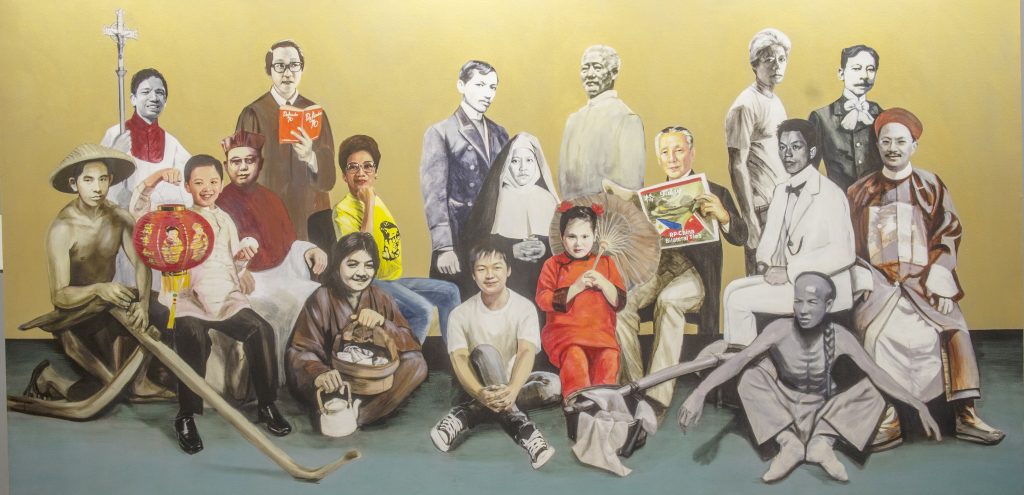
There are ordinary people as well: a young Chinese boy wearing a barong tagalog and holding a red paper lantern, a coolie with his braided Manchu queue, a priest, a nun. The 18 persons are assembled in various poses as if gathered for a group portrait.
During her research for her work, she learned “that President Osmeña was actually the illegitimate son of Don Pedro Lee Gotiaoco, a Chinese immigrant who became a rags-to-riches tycoon. However, because of the stigma of illegitimacy, this fact had been kept hidden from the public for a time. Still, Osmeña did not let his status stop him from becoming a respected statesman and President of this country.
“I thought to myself that Tsinoys are often considered illegitimate Filipinos too. And yet many Tsinoys have proven – through much blood, sweat, and tears – that they love this country as much as any other person. So it seemed fitting that in this reunion, the illegitimate son should finally be able to come home and sit in a place of prominence.”
Tulay, Kaisa
“Tulay is the Filipino word for bridge, and the (newspaper Tulay) is thus a fitting symbol and example of efforts to bridge the gap between the Tsinoy minority and mainstream Filipino society. For this and all things Tsinoy, (Tulay publisher Kaisa Para Sa Kaunlaran) is doing a great job of helping the Filipino Chinese discover and understand their roots. I cannot stress how invaluable that is.
“When my friends and I were growing up, we did not have this resource. We grew up unsure of who we were, and feeling like outsiders to both Chinese culture and Philippine society.
Now my children and their generation have a more secure grasp of their history and identity. And they are proud of it. But beyond that, and perhaps more importantly, Kaisa is helping mainstream Filipino society realize that Tsinoys are not second-class citizens, but Filipinos too.”
Becoming an artist is not a typical calling for Tsinoys of Young’s generation. Yet art calls to her. If she had not become a painter, she might have become a fashion designer or interior decorator.
Art has been her life. And from her life lessons, she tells young aspiring artists talent is only half the picture. They must work hard as well.
“Practice to strengthen your arm and fingers to produce strong and steady strokes.
“Failure is always a forward and upward step towards something better. Don’t be a perfectionist, just do your best.”
Young says if she had not been a painter, she could have been a fashion designer or an interior decorator.
“I also like plants, interior design, fashion design and music.I can sing soprano as well as the alto part, and perhaps many of you do not know: I’m left-handed.” — First published in Tulay Fortnightly, Chinese-Filipino Digest 28, no. 1-2 (June 16-July 6, 2015): 22-23.
